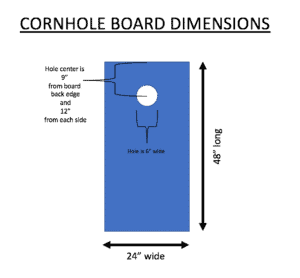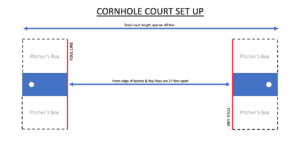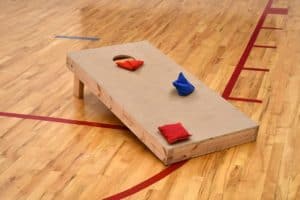
Cornhole Rules, Distance, Scoring and Tips – Your Ultimate Guide to Cornhole
Originally posted on https://thegameroomreview.com/cornhole-rules-distance-scoring/
No outdoor social event is complete without a game of cornhole. It’s incredibly fun for all different kinds of people, and anybody can play! Though cornhole has has roots from over 100 years ago, it’s exploded in popularity over the last couple of decades.
In this post we’ll dive into everything you could possibly need to know about cornhole. Cornhole rules, its history, tips for playing better, and much more!
Cornhole Rules
Cornhole rules are pretty straightforward for the most part. The cornhole rules we always recommend come from the American Cornhole Association, which governs tournaments and whose mission is to help players enjoy the game of cornhole! There are other governing bodies for cornhole rules, but we think the ACA provides the best set of guidelines.
Cornhole Board Dimensions
There are very specific cornhole board dimensions that make up what an acceptable cornhole board size is.
Each cornhole board should be between 47.5 and 48 inches in length, and between 23.5 to 24 inches wide.
The rectangle that makes up the length and width of the board should be at least 0.5 inches thick.
The front edge of the board should be between 3 and 4 inches off of the ground. The back edge of the board should be about 12 inches off of the ground, implying 8 or 9 inches of tilt from the front to back edge of the board.
One each cornhole board there is a hole which serves as the main target for tosses. The hole is 6 inches in diameter. Measuring from the center, the hole should be 9 inches from the back edge of the board and 12 inches from either side edge.


Cornhole Board Surfaces
Sanctioned tournaments are only played on true wood surfaces. This is because there is a huge difference in how the cornhole bags react across wood, plastic, and any other surface.
You might have noticed, for example, that bags don’t slide very much at all on plastic surfaces. On the other hand, a finished wood surface can facilitate quite a bit of slide.
Official cornhole rules stipulate that a board should be sanded and finished to a very smooth texture. There shouldn’t be any blemishes on the wood that would alter play. You want a consistent playing surface for your cornhole games!
You are allowed to play with a board that has a semi-gloss exterior latex paint which helps create more slide. There shouldn’t be so much slide on your board though that it’s not possible for bags to come to a stop on the playing surface.
Most reputable companies that sell cornhole boards know all of this, and sell boards that are made to regulation cornhole board dimensions and surface requirements. It’s just always good to know the correct cornhole rules!
Regulation Cornhole Distance
Cornhole rules continue with proper set up of the cornhole playing field. The regulation cornhole distance is 27 feet from front edge to front edge of either board.
Cornhole Pitcher’s Boxes
The pitcher’s box is the area where players throw their cornhole bags from. It’s a rectangle 4 feet by 3 feet that is on either side of both boards. The pitcher’s boxes are parallel to the cornhole board.
Foul Lines
Foul lines for adult play are 27 feet apart from each other – so it’s an extension of the front edge of each cornhole board. Each foul line should be parallel to the front edge of the opposite board. You can either draw a line to mark the foul line or just use an imaginary one!
Note – the regulation cornhole distance for juniors is 12-15 feet from front edge to front edge of each board.

Cornhole Bags
Note* we’ve done an entire post on how to make cornhole bags if you have the itch for a DIY cornhole bag project! Each cornhole set should come with 8 bags in two different colors. Each there should be 4 bags of each color.
Cornhole bags have very specific guidelines. Each bag should be made of two fabric squares that are 6.25 inches long on each side with a 0.25 inch stitch seam sealing all four sides.
The insides of each bag should be filled with about 2 cups of feed corn. Most people don’t realize that regulation cornhole bags can be filled with actual corn! Many folks choose to use bags with a synthetic plastic pellets, which are also an approved filling.
No matter which filling is used, a finished cornhole bag should be about 6 inches on each side and weigh between 14 to 16 ounces.
Cornhole Rules – Procedure and Scoring
Now that we’ve got the cornhole board, field, and equipment setup down, we can move on to the game itself! Specifically how cornhole is played and how it’s scored.
Each match can be sub divided into innings of play. Each inning is completed when each player has thrown all four of their bags.
Cornhole can be played with 2 or 4 players. With 2 players, each mach is 1 vs 1 and with 4 players it’s a 2 vs 2 game.
Singles Cornhole Game Procedure
Cornhole rules for a 1 vs 1 game go as follows:
- Each player should remain in their own lane for the entire game. If multiple matches are played, then you should alternate lanes with each new match.
- Both players begin at the same cornhole board. Players will alternate pitching their bags (without stepping over the foul line!) at the opposite board until both players have pitched all of their bags.
- After all bags are pitched, both players walk to the other side of the court (we’ll get to cornhole scoring in a moment). This concludes the inning and the score should be tallied and added to the total match score.
- Players then pitch back towards the other board, and repeat until one player accumulates enough points to win!
Doubles Cornhole Game Procedure
Cornhole rules for a 2 vs 2 game look very similar to a singles game with the exception of a few nuances:
- Each team should stay in their designated lane for the entire game. If multiple matches are played, then you should alternate lanes with each new match. Teammates should stand at opposite boards from one another, but in the same lane. This means you should be standing next to an opponent at your board.
- Pick a side to begin from. Each player from that side will alternate pitching bags until both players have pitched all 4 of their bags.
- Players at the opposite board take score, tally it up, then pitch back towards the board opposite of them.
- Repeat pitching back and forth until one team accumulates enough points to win.
Cornhole Scoring
Now for the fun stuff – scoring!
All scoring in cornhole is done on a net basis. For example, imagine team A pitches 7 points in an inning and team B pitches 4 points in the same inning. This results in team A earning 3 points (because 7 minus 4 is 3). With net or cancellation scoring, only one team will actually score points in any inning.
- 1 Point is awarded for any toss that results in a bag coming to rest anywhere on top of the board. This is also known as a Woody.
- 3 Points are awarded for any toss that is thrown through the hole. Note that bags can also be knocked into the hole by other bags for 3 points also. This is also known as a Cornhole!
- Fouls are any bags that do not come to rest on top of the board or in the hole. A bag that ended up on top of the board or in the hole via a rules violation can also be a foul bag. Foul bags are worth 0 points.
 In this picture, the red team scores 1 point for net scoring, assuming there aren’t any bags in the hole.
In this picture, the red team scores 1 point for net scoring, assuming there aren’t any bags in the hole.
Length of the Game
Games are played until one team has accumulated 21 or more points at the conclusion of an inning.
Obviously if you are playing casually, feel free to play to a different score like 15 or 11 for quicker games.
If you want to spice things up, you can also play cornhole rules where any team that goes over 21 points “busts” and gets penalized down to 15 points. This is a super fun variation to play – it takes a little bit of cornhole strategy to land on exactly 21 points.
Cornhole Pitching Rotation
For a singles game, the player who scored in the inning before has the honors and should pitch first in the new inning. In doubles, it’s the exact same thing – the team who scored in the inning before gets the honors and pitches first in the new inning.
In the very first inning, neither team will have scored yet in the match because there is no previous inning. In tournament play you can have the lower seeded team pitch first in the first inning, or you can always just use a chance game like rock paper scissors or a coin flip.
Player Positioning While Pitching
While pitching, you must be behind the foul line and/or within the pitcher’s box when you release your bag.
You must release all four bags from your designated pitcher’s box. In other words you can’t cross over from one pitcher’s box to another.
All players must toss their bags underhanded. No overhand or sidearm tosses.
Cornhole Rules Violations
There are a few rules violations that you should be aware of which will result in a foul bag, even if they end up landing on the board or in the hole. In the event a foul bag lands on the board or in the hole, they should be removed before the next pitch is made. The following all result in cornhole rules violations:
- Stepping over the foul line or outside of the pitcher’s box before your bag is released.
- Pitching a bag from the incorrect pitcher’s box.
- Bags that contact the court or ground before coming to rest on the board.
- Bags that strike a foreign object such as a ceiling, wire, tree limb, etc.
- Removing a bag from the board before you and your opponents agree on the scoring for that bag. If this happens cornhole rules stipulate that the perpetrator (or their team) forfeits any remaining bags to be thrown for the current inning. The non-offending team tallies 12 points as if they threw 4 holes in the circle. This is one you want to make sure you don’t accidentally do!
A couple of other cornhole rules to be aware of:
- If you accidentally drop a bag after the forward motion of your pitch has begun, then it counts as a pitched bag. Even if it slipped out of your hand and went nowhere down the court.
- Any bag that is accidentally dropped on the backswing or before the forward motion of your pitch has begun does not count as a pitched bag.
Cornhole History
Now that we’ve gone over cornhole rules, it’s a great point in this article to go over some cornhole history!

Who Invented Cornhole?
Cornhole history begins with a patent filed in 1883 by an American named Heyliger de Windt. The name of his game was “Parlor Quoits”, and it very closely resembles the game we all know and love today. Heyliger de Windt was the first person to use a slanted board with a hole as a target for bean bags.
Where Was Cornhole Invented?
Heyliger de Windt was an American who lived in New York – he eventually sold the rights to his game to a Massachusetts based game manufacturer. This manufacturer took the rights to create and market a game called Faba Baga.
Faba Baga was extremely similar to modern day cornhole except for that the boards had two holes with different point values for throwing in each hole. There was also an extra bag for each team that was worth double points.
Why is it Called Cornhole?
At this point you may be wondering how we got to the name “cornhole” from Parlor Quoits and Faba Gaba. The truth is, it’s a little bit unclear how exactly the cornhole history goes when it comes to the name.
Initially, Faba Baga was a pretty popular game. Interest tapered and eventually fell off after a few years, but the game never truly went away. Over time, the game morphed into the rules we know today. Along the way, it’s gone by quite a few different names: Bag Board, Dummy Boards, Soft Horseshoes, Baggo, Corn Toss, Bean Bag, Bean Toss, and Indiana Horseshoes amongst others.
The name cornhole specifically started being used in the 1990’s, and it’s most commonly attributed to being a not to the basic function of the game – bags of corn get tossed into a hole. Although this logical reasoning makes a ton of sense, it’s not 100% clear where or when this name for the game originated.
Modern Day Cornhole History
In the 2000’s, various organizations began to pop up with the intent of popularizing and regulating the game. Namely, the American Cornhole Organization (ACO), the American Cornhole League (ACL), and the American Cornhole Association (ACA) all promote the game and facilitate tournaments.
Cornhole Tips
Even if you play cornhole only at the local bar or pub, it’s impossible not feel the competitive juices flowing once a game starts. Here are some cornhole tips you can use in your next game to help you secure the victory!
Relax – both mentally and physically. Posture wise, you shouldn’t be uptight and stiff. A good throwing motion is smooth and fluid. That can’t happen if your body isn’t relaxed. Mentally, a clear mind can help you tremendously. Worrying about how much you are down or how bad your last toss was can lead to poor play and decision making in the future. Get into a relaxed frame of mind!
Be consistent with your stance and pitch. The way you pitch the bags should be simple and easy to repeat. A lot of players will use their dominant hand to toss while they take a step forward with their opposite foot. Your arm motion should swing smoothly like a pendulum. There really isn’t need for acceleration or a jerky throwing motion. A consistent toss is key to becoming a better player.
Don’t aim for the hole. As strange as that might sound, players who aim for the hole can have a very hard time scoring points. Think about it, the surface area of each cornhole board is 8 square feet. The hole has a 6 inch diameter and only takes up about 0.2 square feet. It’s also only 9 inches away from the back edge of the board. Relative to the rest of the board, the hole is a really small target. If you are aiming for the hole odds are high that your bag will miss and slide off the back, leaving you with no points.
Try to land bags on the front of the board. This is a much better cornhole strategy. A well made cornhole board will facilitate some slide. So if you land a bag on the front foot of the board, there is a good chance that your bag will either a) remain on the board for a point or b) slide up into the hole for 3 points.
Toss your bag flat and with a little spin. What you don’t want to do is toss the bag end over end. This will make bounces unpredictable and inconsistent. Think about tossing your bag in a way that it will fly similar to a frisbee. You want the bag to stay flat, maybe with the leading edge tilting slightly down. A little bit of spin (also like a frisbee) will make the flight more consistent.
Practice an airmail shot, just in case. Situations will arise where it does make sense to try to make a shot into the hole that needs to be done in the air. This could be if your opponents bags are guarding the hole and you need to score a cornhole to avoid losing the game. To maximize the chances of making your airmail shot, put a little extra loft on your pitch and make sure you follow through directly at your target!
Cornhole Terminology
As with any game, cornhole has a specific set of words and phrases that are associated with the game. You may not see these term on a cornhole rules sheet but they are commonly said amongst players. Here is a list of terms you might come across during a game of cornhole:
Ace – another term for a bag toss that hits and stays on the board for 1 point.
Air Mail – describes a shot where you toss your bag inside of the hole without touching the board. Kind of like a swish in basketball!
Back Door – a shot that finds it’s way into the hole when an opponent’s Blocker is in the way. This could be via Air Mail or a shot that bounces.
Backstop – a bag that finishes on the back edge of the board and serves as a backstop of sorts for any subsequent tosses remaining in that inning.
Blocker – a bag that finishes in line with the hole and blocks other bags from being able to slide into the hole. If blockers finish directly in front of the hole, they can easily be knocked in by other bags too.
Cornhole – the name of the game and also a term for when a 3 point toss is made by a player throwing a bag into the hole.
Dirty Bag – used to describe when a bag hits the ground before bouncing up and finishing on the board. It can also describe when a bag slides partially off of the board and part of it touches the ground. No points are awarded for dirty bags.
Fault – when a player steps over the foul line on a bag toss. No points are awarded on a fault no matter where the bag ends up.
Flop – a throwing style where your bag has no spin or rotation during its flight.
Frisbee – a throwing style (that we recommend) where your bag flies flat in the air while spinning like a frisbee. Throwing frisbee style helps the bag stay on the board after landing. Note – you don’t throw with the same technique as a frisbee. You still toss the bag underhanded but you want to try to spin it like a frisbee.
Hammer – the last bag tossed in an inning can be referred to as the hammer.
Hanger – refers to a situation where a tossed bag lands on the board with some portion of it leaning over the hole. Hangers are only worth 1 point – the entire bag has to go through the hole for 3 points to be awarded.
Honors – the team who scored in the previous inning and now is due to pitch first in the next inning has the honors.
Leaner – a Leaner is the same thing as a Hanger. A bag that has some portion of it hanging over the hole but is not all the way through.
Push Bag – when a bag pushes bags already on the board into the hole.
Skunk – in some house rules, a skunk is in play. Skunks occur when one team starts the game with an 11-0 lead. If a skunk score is reached, the game is over.
Slider – a bag that lands on the front or middle of the board and slides into the hole.
Woody – when a bag lands and comes to rest on the board for 1 point.
Cornhole FAQ
Over the years I’ve heard quite a few questions related to cornhole rules, strategy, tips, and many other things. Below is a list of the questions I’ve heard often relating to cornhole:
What are Other Names for Cornhole?
Cornhole as we know it today has gone by many other names, including: Bag Board, Dummy Boards, Soft Horseshoes, Baggo, Corn Toss, Bean Bag, Bean Toss, Bean Bag Toss, and Indiana Horseshoes. I’m sure there are more names it’s gone by in the past too! The different names are largely dependent on which region the game is being played in.
Can I Make My Own Cornhole Bags?
Yes! It will take a little bit of work and stitching know how, buy DIY cornhole bags are certainly possible. In fact, we’ve written an entire post outlining how to make cornhole bags right here.
Cornhole Distance – How Far Apart are Cornhole Boards?
One of the most common questions I hear is what is the proper cornhole distance? The answer is that the front edges of either board should be 27 feet apart from each other. For juniors, the front edges should be 15 feet apart from each other.
What is the Official Cornhole Bag Weight?
The weight per cornhole bag should be between 14-16 ounces.
What is the Official Cornhole Bag Size?
Cornhole bags are 6″ wide and 6″ long, and roughly 1″ thick.
All Weather vs Corn Filled Bags – What is the Difference?
It’s true that multiple types of filling are acceptable in regulation cornhole bags. The real question is though, what’s the difference between all weather vs corn filled bags?
Corn filled bags are true to the games namesake and in some people’s minds provide a “truer” cornhole experience. A fine dust comes off of the corn over time which adds a chalky quality to the bags, which makes them easier to grip. The dust also sticks to the bag itself and will cause it to slide more than non corn filled bags.
The downside is that corn filled bags decay over time, especially if they are exposed to the rain and other elements. And storing them outside may be difficult with critters trying to get in there and eat the corn. It is food after all!
All weather bags on the other hand are made of a synthetic material – typically some kind of plastic based pellet. Generally speaking, all weather bags will slide less on the board and not give a true to the roots authentic experience. But most importantly, they will last quite a long time. Hopefully this provides a little color on the difference in all weather vs corn filled bags.
Can a Cornhole Bag Touch the Ground?
No – if a cornhole bag touches the ground at any moment during or after the toss, zero points are awarded for that bag. Of course you could make house rules to allow for it, but every official set of cornhole rules does not allow scoring if the bag touches the ground.
Can I Toss Overhanded?
Also no. Cornhole bags must be tossed underhanded. Any bags pitched with an overhand or sidearm motion are fouls and no points resulting from those pitches count.
How Many Points do You Play to in Cornhole?
Official Cornhole games go until one team has scored 21 points or more. You can of course play cornhole scoring variations if you’d like. I’ve seen people play to 11 or 15 to make games go by quicker.
Can you Bust in Cornhole?
In the official cornhole rules no, you cannot bust. The first team to get 21 or more points wins. Like we’ve said before in this post, you can play with busting as a variation of the game to add strategy, but that’s not the way cornhole is officially played.
How Many Points are Hangers Worth in Cornhole?
1 point. There are no extra points awarded for your bag leaning over the edge of the hole. If the bag goes all the way in the hole, it’s 3 points.
Cornhole Rules Ultimate Guide – Wrap Up
Hopefully this guide has helped you with your knowledge of cornhole! Next time you are at a tailgate or outdoor party, be sure to remember some of the tips and tricks in this post to get a leg up on your opponents.
If you think we left anything out, please reply in the comments section below!
